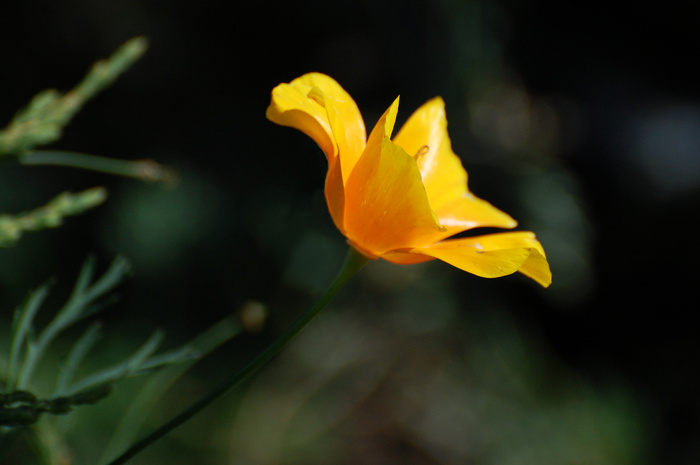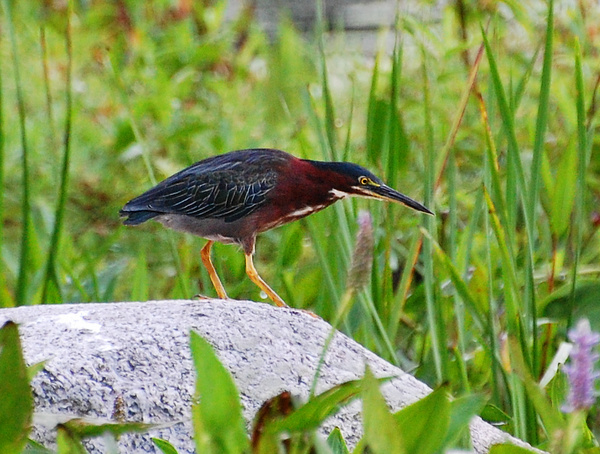
Sunshine
September 14th, 2010

A Single Candle
September 13th, 2010

1680x1050 wallpaper
Montreal Botanical Gardens (Plan B)
September 11th, 2010
So today our big plan (me, Mike, and my folks, visiting from the states) was to go to the Biodome. I was all psyched to introduce my mom to the place; she's a nature-lover like me. I brought my camera. We were slated to arrive in the early afternoon. I figured that was the perfect time, on the perfect day, to take advantage of the big skylights in some of the exhibits and get good photos sans flash. Tropical birds, Canadian birds, diving ducks up close, various mammals and reptiles. Like a fool, I never bothered to, say, call them up, or have a look at their handy easily-accessible website, which might have changed my mind about a thing or two.
So we drove two point something hours from Ottawa to Montreal and...well, have you ever seen National Lampoon Vacation? Remember how they arrive to an empty parking lot and go "oh hey, we're the first ones here!" and then they run joyously to the entrance to the accompaniment of "Chariots of Fire", and then they finally get there and see the big "closed" sign and the statue of Marty Moose with the speaker in it that says, "Sorry folks!" And then Chevy Chase buys a gun and hijacks a roller coaster and shoots John Candy in the butt? Yeah, that.
Except for that last part.
But believe me, we thought about that last part.
Plan B was the Botanical Gardens. Which was nice. I think the Chinese garden was my favorite of those we saw. My pictures are mostly shite. Too much sun, bleaching all the color out. I had timed us for indoors-with-skylights photography, not outdoors photography. I did manage to get a few good ones later in the afternoon, or with the sun behind a tree. Haven't decided how many I'll post yet.
This one, at least.

It's called a Torch Lily.
Fascinating fact #2
August 30th, 2010
I love this book.
It has taken decades for ornithologists to figure out what's up with Ruffs [link mine]. First, Ruffs breed on what are known as leks--display courts where females come to choose a mate and copulate. [...] Male Ruffs follow one of three distinct reproductive strategies: a dominant and aggressive strategy, a subordinate and passive strategy, and a "sneaker" strategy. Males with dark ruffs or dark head tufts are the dominant males. Males with white ruffs and white or rusty head tufts are satellites. Males in female-like plumage and with small body size are sneakers. These plumage types and associated strategies are genetically determined, fixed at the moment of conception.
[...] The aggressive strategy of males with dark ruffs constitutes the most common reproductive strategy. These males fight vigorously among themselves for the best positions on the lek, and females tend to mate with the males that hold these favored lekking positions. [...] Males with white ruffs and head tufts play the role of satellites, meaning that they do not attempt to defend a particular spot on the lek. White-morph males are not aggressive and always submit to dark-morph males. White-morph males actually form mutualistic displays with dominant males. Many dominant, dark-morph males tolerate a white-morph male on their territories--often right in the heart of the lek--and the two males will display together with ritualized satellite-dominant displays. Studies show that dark-morph males with white-morph males on their territories are more attractive to females than dominant males without satellites. Despite their passive behavior and subordinate role, white-morph males are about as successful at fertilizing females as dark-morph males.
[...] Perhaps the most fascinating reproductive strategy employed by male Ruffs is the sneaker strategy. Sneaker males lack a ruff and have plumage coloration that is exactly like the plumage of Reeves [female Ruffs]. As a matter of fact, these sneaker males are so cryptic that they were overlooked by ornithologists through nearly 90 years of studies on Ruffs. The sneaker strategy was described only in 2006. Sneaker males not only look like females but act like females. They are smaller than ornamented males and their cryptic appearance and behavior deceive dominant males most of the time and allow sneaker males to penetrate unchallenged right to the heart of the lek.
Sneaker males do whatever it takes to keep dark-morph males from copulating with females and to gain mating opportunities for themselves. When a dominant male approaches a receptive female, a sneaker male tries to insert itself between the pair or will crouch like a female to entice the dominant to mount him rather than the female. Following such a ruse, females will sometimes copulate with the sneaker.
- National Geographic Bird Coloration
Fascinating fact
August 29th, 2010
Birds see ultraviolet.
They have four cones. While we have red, green, and blue cones that respond (respectively) to long-wave, medium-wave, and short-wave light, birds have all those plus a fourth cone that responds to very-short-wave light--ultraviolet light. Essentially, birds have four primary colors to our three. (So do many fish, reptiles and insects.) They see not only UV itself, but various secondary colors that come from the combination of UV with red, green, or blue. None of this is conceivable to a mammal. Even if we could give a human being UV cones, they still wouldn't see the world the way birds do, because their brains aren't set up to process the fourth input.
The Yellow-Breasted Chat, for instance--an oversized warbler found in the states and far-south Ontario--has a breast which reflects both yellow light and UV light. Thus, when Yellow-Breasted Chats look at each other, they don't see yellow breasts. They see a bright color that is completely beyond our experience or conception.
- Paraphrased from National Geographic Bird Coloration
Of ducks and deer and goatsuckers
August 22nd, 2010
Had a great time today hiking Stony Swamp with Michael. We went first to Sarsaparilla Trail, then Jack Pine. It was a gray, drizzly day, with the potential for heavier rain--I went out in it because I was stir crazy from having been sick, and Mike just sort of got pulled along by my enthusiasm, I guess. It turned out surprisingly pleasant. Deep woods are a good place to spend gray days.
Sarsaparilla was a disappointment. I'd never been there before. I think we must have missed something. As best we could tell there was no more than five minutes of hiking to be done.
Jack Pine was, as usual, a pleasure. Three highlights: one was a doe with a quite young spotted fawn in the woods. Two was a probable female/eclipse Green-Winged Teal flushing from an open area of the marsh. The speculum looked more blue-green than the pure green I expect, but I think it can appear like that in certain light. The duck looked too small to be a mallard or black--a mallard or black that size shouldn't be old enough to fly yet--plus, it flushed as soon as it saw us and flew far away, while the other ducks, all blacks and mallards, some with young, were completely unfazed, not even bothering to swim farther away.
Highlight number three was the big one. At least three, maybe four Common Nighthawks! They were circling across the water from us. Nighthawks are crepuscular (active at dawn and dusk) birds who hunt insects on the wing. They're not actually hawks, but nightjars, which is known more colorfully as the goatsucker family (apparently our ancestors considered them an ill omen). They're identifiable in flight even at a great distance thanks to the white bars across their wing tips. I can count on one hand the number of sightings of this species I've tallied--and this was the closest I'd ever seen them.
They looked very like falcons to me. I wondered if any of the local songbirds had the same impression!
Downy Woodpecker
August 20th, 2010

I think I caught this guy waking up. It was around sunrise. He clung to the branch for some time, blinking, before he finally flew off.
Great Blue Portrait
August 16th, 2010

1680x1050 wallpaper
American Redstart
August 13th, 2010
American Redstarts are common at Mud Lake and other places, but the striking black-and-orange adult male is hard to photograph: he tends to perch high up while he sings; if you happen to catch him low, he'll probably flush before you can get a picture, or just stay extremely well-hidden behind multiple layers of foliage. All my best redstart photos have been taken at around this time of year, when bushes, low branches and undergrowth teem with fledglings. They don't seem to have learned to be skittish yet.


It looked almost luminous when the "flash patch" on his tail caught the sun.

August Bounty
August 11th, 2010
An incredible morning of birding at Mud Lake on Monday. Surprising numbers of fall migrants, for so early in August, plus lots of resident breeders out and about with their fledged young. Plus two special surprises.
All three of Mud Lake's breeding herons were around: a Green Heron flushed from the northeast shore and landed in a small tree, three juvenile Night Herons flushed one by one from a tree on the ridge, an adult Night Heron flew overhead a short while after that, and Great Blues, of course, were everywhere. Two Pied-Billed Grebes were on the pond. (Apparently a whole family group of Pied-Billed Grebes has been seen on Mud Lake since late July, which raises the question of whether they actually bred there. If so they were very secretive about it.) A Cooper's Hawk stirred things up when he flew low over the ridge, triggering a chorus of alarm calls.
Migrant Yellow-Rumped Warblers, Nashville Warblers, Black-and-White Warblers, Rose-Breasted Grosbeaks, a Cape May Warbler, a Northern Waterthrush and a Least Flycatcher were all present, along with abundant numbers of Mud Lake's breeding songbirds, all gathered into mixed foraging flocks, enjoying both late-summer insects and late-summer ripe berries.
Surprise number one took place at sunrise, when I saw an Osprey dive into Mud Lake and come up with a goldfish! It caught the sun, deep golden-red and at least seven inches long, like the kind you see in garden ponds. Someone must have dumped it in there. Its camouflage was, let us say, lacking.
Surprise number two was a long-awaited lifer: aforementioned Northern Waterthrush. This is not a thrush but a ground-dwelling warbler, known for its habit of bobbing its tail up and down as it walks along wooded swamps. Back when I was a beginning birder, I saw what I thought was a Northern Waterthrush and was thrilled to pieces that I had seen my first non-common-as-dirt bird. It was a letdown when I learned that what I had actually seen was a female Red-Winged Blackbird, which is, in fact, common as dirt. So finally seeing a waterthrush for real is a nice bit of closure.
The next morning I came back with camera in hand. And though both the activity level and novelty level were down from Monday (no osprey with goldfish), I still managed to capture some of August's bounty, which I'll share over the next few days.
Starting with this:

Green Heron
|
